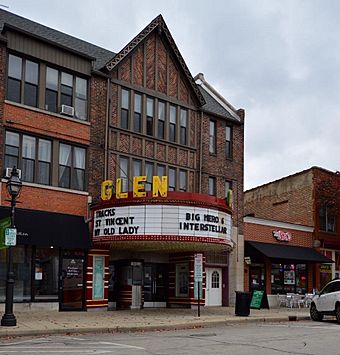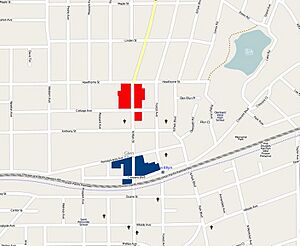Glen Ellyn Downtown North Historic District facts for kids
Quick facts for kids |
|
|
Glen Ellyn Downtown North Historic District
|
|

Glen Theatre
|
|
| Location | Main St., Crescent Blvd., & Pennsylvania Ave. Glen Ellyn, DuPage County, Illinois, U.S. |
|---|---|
| NRHP reference No. | 13000716 |
| Added to NRHP | September 18, 2013 |
The Glen Ellyn Downtown North Historic District is a special area in Glen Ellyn, Illinois. It's called a historic district because it has many old buildings that are important to the town's past. This district is mainly found on Main Street, between Crescent Boulevard and Pennsylvania Avenue. It also includes parts of Crescent and Pennsylvania Avenues.
There are thirty-four buildings in this district. Twenty-eight of these buildings are considered "contributing" because they help show the area's history and unique style.
Contents
History of Glen Ellyn's Downtown
Glen Ellyn, Illinois, was first settled a long time ago, in the 1830s. One of the very first businesses was Stacy's Tavern. This tavern was a place where people traveling by stagecoach could stop and rest.
The Railroad Arrives
In 1849, something big happened: the Galena and Chicago Union Railroad opened a train station nearby. A man named Dr. Lewey Quitterfield Newton convinced the railroad company to build a station in this area. He even helped raise the money for it!
David Kelley built the Mansion House Hotel in 1851. This was the first business right in the heart of what would become the historic district. Kelley named the station and the growing settlement "Danby," after his hometown in Vermont. In 1855, the town of Danby was officially planned out.
Changing Names and Growth
At first, most of the businesses were on the north side of the train tracks. The village changed its name to Prospect Park in 1874. Then, in 1891, it changed again to Glen Ellyn. This last name change happened because of a new resort called the Glen Ellyn Hotel & Springs Company. Even though the resort later burned down in 1906 and wasn't a huge money-maker, it helped make Glen Ellyn known as a beautiful suburb. This encouraged more people and businesses to move to the town center.
In November 1891, a fire destroyed many buildings on the west side of Main Street. But the town rebuilt! In the early 1900s, Glen Ellyn improved its roads and other public services to attract more businesses. As more people wanted to live outside big cities in the 1920s, Glen Ellyn became a very popular place for people moving from Chicago.
Buildings and Their Styles
The Glen Ellyn Downtown North Historic District is known for its interesting buildings. Many of these buildings show off two main architectural styles:
- Chicago School Style: Eight buildings in the district are built in this style. It often features strong, simple designs and large windows.
- Tudor Revival Style: Six buildings have this look. It often includes decorative half-timbering (wood strips on the outside) and steeply pitched roofs, making them look a bit like old English cottages.
Many of these buildings were built in the early 1900s, especially in the 1920s, when Glen Ellyn was growing fast. Some examples of these historic buildings include:
- The Glen Ellyn State Bank, built between 1926 and 1929, which shows the grand Classical Revival style.
- The Glen Theatre, built in 1926, is a great example of the Tudor Revival style.
- The Frederick G. Walker Block, built in 1892, features the Renaissance Revival style.
Many of these buildings have been changed or updated over the years, but they still keep their historic charm and help tell the story of Glen Ellyn's past.




